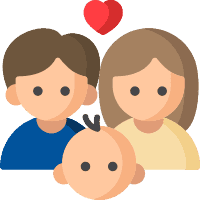The first few years of parenthood are overwhelming, exhausting, joyful, and full of firsts. You are sleep deprived, overwhelmed by all the parenting information (and opinions), and you’re entirely in love with your new baby. Your baby is growing and developing steadily – each day can be full of firsts!
As you watch your little one grow, you might be wondering if your baby is meeting all the right developmental milestones.
Every child develops at their own pace. Some babies reach milestones on time, or even a little early. Other skills might take a little longer to develop. Here is an overview of the skills your child should achieve by the end of 6 months.
Movement, Sensory, and Motor Skill Milestones
In the first six months, your little one should become active, mobile, and begin to interact with the world around them. Pediatricians track many six-month baby milestones in this category to ensure your baby is healthy and growing steadily
Mobility
Being able to lift and control their head is a good milestone by six months old. Babies also begin to roll over in both directions (back to stomach and stomach to back).
Babies should begin to sit unsupported by the end of six months. If you help with their balance, your child should be able to support their weight on both legs. They might even bounce a little and begin to make stepping motions.
While your baby might not be crawling yet, they should begin to start bearing weight on their hands and knees. Babies may even begin to get their hands and knees under them and rock back and forth. Many babies start crawling backward before they learn to crawl forward.
Sensory development
Sight, hearing, touch, taste, and smell develop faster in the first 12 months than any other period of their life. Your baby will quickly begin to express preferences, likes, and dislikes.
Is your baby using both hands to reach for toys and explore their world? Their spatial and depth perception are still developing, but your baby should track people, toys, and objects with their eyes and head. While lying on their back, your baby should reach for toys around them.
Another six-month baby milestone is the ability to pass items from one hand to the other. They should be able to use both sides of their body at the same time (like both hands or feet), and their coordination should be improving quickly.
Mobiles and “overhead gyms” are age-appropriate toys that will help your baby develop eye-hand coordination and eye-tracking. Also, offer toys with different textures, sounds, and shapes.
By six months of age, your baby probably prefers to be carried facing outward so they can see what’s going on around them.
Hearing, Language, and Emotional Development Milestones
Even though your baby isn’t talking yet, six-month baby milestones in this category focus on hearing and language development, and how your baby engages emotionally.
Hearing and Language
Babies in this developmental stage are easily startled by loud or sudden sounds. They typically respond to sounds around them by turning their heads, looking, and making sounds in response.
By six months, most babies recognize and respond to their own name. They also become quiet, smile, and interact when you make eye contact and speak to them. You should notice your baby reacting to changes in your tone of voice.
As they coo and babble, you should hear your baby begin to string vowels together (“ah, “eh,” and “oh” sounds), and start making consonant sounds (like “m,” “b,” “p,” “d,” “t,” “k” and “g”). Your little one should also begin to make exclamations to express emotions, like joy and displeasure.
Babies at this age notice toys that make sounds and often pay attention to music. Talking to your baby is critical for their hearing and language development. Begin to point, show, and name familiar objects and actions in their environment. Toward the end of this developmental stage (0 to 6 months), babies begin to associate sounds with specific objects, and some babies even start to imitate sounds.
Emotional and social
By the end of six months, your child should demonstrate some situational awareness. At this stage, babies typically recognize familiar faces and respond differently to strangers. They should enjoy interacting with others, especially mom, dad, and siblings!
At this stage of development, babies should be content or happy most of the time and respond to other people’s emotions.Fussy babies are typically easy to calm with singing, gentle sounds, rocking, and soothing touches.
Feeding Milestones
By six months of age, everything in their hands goes into their mouths. That’s completely normal, no matter how disgusting or frustrating it might be to you.
Babies begin to reach for bottles when they are hungry. Toward the end of 6 months, they will open their mouth when you touch a spoon to their lips. You might even begin to see a tooth or two!
Babies at this age are attracted to the sweet taste of breastmilk and formula and they can taste changes in your breastmilk. Eating a nutritious diet with a lot of variation helps provide all the right nutrients; it may also help your baby develop their sense of taste.
By the end of six months, your baby will begin to display an interest in other people’s food. Most babies are ready to start trying age-appropriate fruit, vegetables, and cereal purees. It’s normal for babies to lose some food out of the sides and front of their mouth when they first start learning to eat with a spoon.
Your baby’s sense of smell is also developing quickly, and you should notice that they are interested in food smells. They might even start fussing if they smell bad odors (like dirty diapers).
When To Be Concerned
Remember, every baby develops at a different pace. Some children will pass these six-month baby milestones earlier or later than others. However, it’s essential to act early if your child seems noticeably behind or displays signs of developmental delays.
You should speak to your pediatrician or reach out to a professional if your six-month-old baby has not reached these milestones by the end of six months:
- Grab things within reach
- Respond to noises around them
- Show affection for known adults and caregivers
- Easily put varying textures in their mouth
- Make sounds when babbling
- Laugh and make noises expressing joy
- Rolling over in both directions (stomach to back and vise versa)
- Seems unnaturally stiff and rigid or very “floppy” and lacking muscle development
The Center For Speech & Language Development is here to support you and your little one through every stage of development. Our staff of friendly, knowledgeable therapists can assess your child and offer the right intervention and therapies to help your little one get back on track. We also provide helpful resources and support for parents throughout the process.


